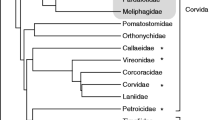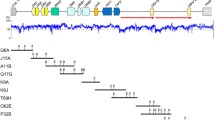Abstract
The major histocompatibility complex (MHC) has been studied in a multitude of mammals by now, but much less is known about its organisation and variation in other vertebrate species. The mammalian MHC is organised as a single gene cluster, but recent studies on birds suggest that this paradigm of MHC organisation has to be supplemented. The domestic chicken thus possesses two separate gene clusters which both contain MHC class I and class II B genes, and we have shown that the ring‐necked pheasant Phasianus colchicus also has two unlinked clusters of class II B genes. We are studying the effect of the MHC on mate choice, survival and reproductive success in natural populations of birds and reptiles. For this reason, we are developing DNA techniques to determine the animals' MHC genotype. The amplification of the hypervariable exon 3 of the class I gene from songbirds and reptiles has provided us with species specific probes that can be used in Southern blot analysis. The first results indicate very extensive variation in all studied species, that is starlings Sturnus vulgaris, great reed warblers Acrocephalus arundinaceus and water pythons Liasis fuscus. The restriction fragment length polymorphism (RFLP) analysis also suggests that the number of MHC genes is significantly larger in these species than in pheasants and domestic chickens.
Similar content being viewed by others
References
Bensch, S., D. Hasselquist & T. von Schantz, 1994. Genetic similarity between parents predicts hatching failure: Nonincestuous inbreeding in the great reed warbler? Evolution 48: 317-326.
Bourlet, Y., G. Béhar, F. Guillemot, N. Fréchin, A. Billault, A.-M. Chaussé, R. Zoorob & C. Auffray, 1988. Isolation of chicken major histocompatibility complex class II (B-L) ß chain sequences: Comparison with mammalian ß chains and expression in lymphoid organs. EMBO J. 7: 1031-1039.
Edwards, S.V., M. Grahn & W.K. Potts, 1995. Dynamics of Mhc evolution in birds and crocodilians: Amplification of class II genes with degenerate primers. Mol. Ecol. 4: 719-729.
Ellegren, H., G. Hartman, M. Johansson & L. Andersson, 1993. Major histocompatibility complex monomorphism and low levels of DNA fingerprinting variability in a reintroduced and rapidly expanding population of beavers. Proc. Natl. Acad. Sci. USA 90: 8150-8153.
Grossberger, D. & P. Parham, 1992. Reptilian class I major histocompatibility complex genes reveal conserved elements in class I structure. Immunogenetics 36: 166-174.
Guillemot, F., A. Billault, O. Pourquié, G. Béhar, A.-M. Chaussé, R. Zoorob, G. Kreibich & C. Auffray, 1988. A molecular map of the chicken major histocompatibility complex: The class II ß genes are closely linked to the class I genes and the nucleolar organizer. EMBO J. 7: 2775-2785.
Hamilton, W.D. & M. Zuk, 1982. Heritable true fitness and bright birds: A role for parasites? Science 218: 384-387.
Jarvi, S.I., R.M. Goto, W.E. Briles & M.M. Miller, 1996. Characterization of Mhc genes in a multigenerational family of ring-necked pheasants. Immunogenetics 43: 125-135.
Kroemer, G., A. Bernot, G. Béhar, A.-M. Chaussé, L.-N. Gastinel, F. Guillemot, I. Park, P. Thoraval, R. Zoorob & C. Auffray, 1990a. Molecular genetics of the chicken MHC: Current status and evolutionary aspects. Immunol. Rev. 113: 119-145.
Kroemer, G., R. Zoorob & C. Auffray, 1990b. Structure and expression of a chicken MHC class I gene. Immunogenetics 31: 405-409.
Lessa, E.P. & G. Applebaum, 1993. Screening techniques for detecting allelic variation in DNA sequences. Mol. Ecol. 2: 119-129.
Lie, O., A. Slettan, U. Grimholt, M. Lundin, M. Syed & I. Olsaker, 1994. Fish gene maps and their implications for aquaculture. Anim. Biotechnol. 5: 209-218.
Madsen, T. & R. Shine, 1996. Seasonal migration of predators and prey - a study of pythons and rats in tropical Australia. Ecology 77: 149-156.
Madsen, T., B. Stille & R. Shine, 1996. Inbreeding depression in an isolated population of adders Vipera berus. Biol. Conserv. 75: 113-118.
Mikko, S. & L. Andersson, 1995. Low major histocompatibility complex class II diversity in European and North American moose. Proc. Natl. Acad. Sci. USA 92: 4259-4263.
Miller, M.M., R. Goto, A. Bernot, R. Zoorob, C. Auffray, N. Bumstead & W.E. Briles, 1994. Two Mhc class I and two Mhc class II genes map to the chicken Rfp-Y system outside the B complex. Proc. Natl. Acad. Sci. USA 91: 4397-4401.
Miller, M.M., R.M. Goto, R.L. Taylor Jr., R. Zoorob, C. Auffray, R.W. Briles, W.E. Briles & S.E. Bloom, 1996. Assignment of Rfp-Y to the chicken major histocompatibility complex/NOR microchromosome and evidence for high-frequency recombination associated with the nucleolar organizer region. Proc. Natl. Acad. Sci. USA 93: 3958-3962.
Olsson, M., A. Gullberg, R. Shine, T. Madsen & H. Tegelström, 1996a. Paternal genotype influences incubation period, offspring size, and offspring shape in an oviparous reptile. Evolution 50: 1328-1333.
Olsson, M., R. Shine, T. Madsen, A. Gullberg & H. Tegelström, 1996b. Sperm selection by females. Nature 383: 585.
Parham, P. & T. Ohta, 1996. Population biology of antigen presentation by MHC class I molecules. Science 272: 67-74.
Potts, W.K., C.J. Manning & E.K. Wakeland, 1991. Mating patterns in seminatural populations of mice influenced by MHC genotype. Nature 352: 619-621.
Radtkey, R.R., B. Becker, R.D. Miller, R. Riblet & T.J. Case, 1996. Variation and evolution of Class I Mhc in sexual and parthenogenetic geckos. Proc. Royal Soc. London B 263: 1023-1032.
Shiina, T., A. Ando, T. Imanishi, H. Kawata, K. Hanzawa, T. Gojobori, H. Inoko & S. Watanabe, 1995. Isolation and characterization of cDNA clones for Japanese quail (Coturnix japonica) major histocompatibility complex (MhcCoja) class I molecules. Immunogenetics 42: 213-316.
Slade, R.W., 1992. Limited MHC polymorphism in the southern elephant seal: Implications for MHC evolution and marine mammal population biology. Proc. Royal Soc. London B 249: 163-171.
Trowsdale, J., 1995. Both man & bird & beast: Comparative organization of MHC genes. Immunogenetics 41: 1-17.
Trowsdale, J., V. Groves & A. Arnason, 1989. Limited MHC polymorphism in whales. Immunogenetics 29: 19-24.
Vincek, V., D. Klein, R.T. Graser, F. Figueroa, C. O'hUigin & J. Klein, 1995. Molecular cloning of major histocompatibility complex class II B gene cDNA from the Bengalese finch Lonchura striata. Immunogenetics 42: 262-267.
von Schantz, T., H. Wittzell, G. Göransson, M. Grahn & K. Persson, 1996. MHC genotype and male ornamentation: Genetic evidence for the Hamilton-Zuk model. Proc. Royal Soc. London B 263: 265-271.
Westerdahl, H., 1995. The variability of MHC genes in the great reed warbler, and implications for mate choice and offspring survival. Honours Thesis in biology, Lund University.
Wittzell, H., T. von Schantz, R. Zoorob & C. Auffray, 1994. Molecular characterization of three Mhc class II B haplotypes in the ring-necked pheasant. Immunogenetics 39: 395-403.
Wittzell, H., T. von Schantz, R. Zoorob & C. Auffray, 1995. Rfp-Y-like sequences assort independently of pheasant Mhc genes. Immunogenetics 42: 68-71.
Yamazaki, K., E.A. Boyse, V. Miké, H.T. Thaler, B.J. Mathieson, J. Abbott, J. Boyse, Z.A. Zayas & L. Thomas, 1976. Control of mating preferences in mice by genes in the major histocompatibility complex. J. Exp. Med. 144: 1324-1335.
Yamazaki, K., G.K. Beauchamp, D. Kupniewski, J. Bard, L. Thomas & E.A. Boyse, 1988. Familial imprinting determines H-2 selective mating preferences. Science 240: 1331-1332.
Yuhki, N. & S.J. O'Brien, 1990. DNA variation of the mammalian major histocompatibility complex reflects genomic diversity and population history. Proc. Natl. Acad. Sci. USA 87: 836-840.
Zoorob, R., G. Béhar, G. Kroemer & C. Auffray, 1990. Organization of a functional chicken class II B gene. Immunogenetics 31: 179- 187.
Zoorob, R., A. Bernot, D. Martel Renoir, F. Choukri & C. Auffray, 1993. Chicken major histocompatibility complex class II B genes: Analysis of interallelic and interlocus sequence variation. Eur. J. Immunol. 23: 1139-1145.
Author information
Authors and Affiliations
Rights and permissions
About this article
Cite this article
Wittzell, H., Madsen, T., Westerdahl, H. et al. MHC variation in birds and reptiles. Genetica 104, 301–309 (1998). https://doi.org/10.1023/A:1026421607089
Issue Date:
DOI: https://doi.org/10.1023/A:1026421607089




